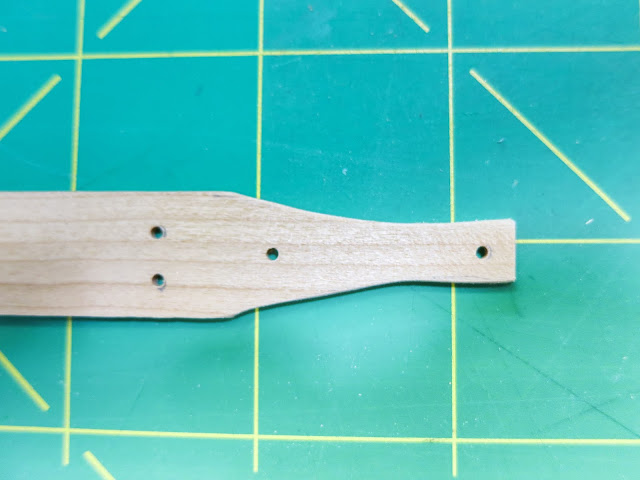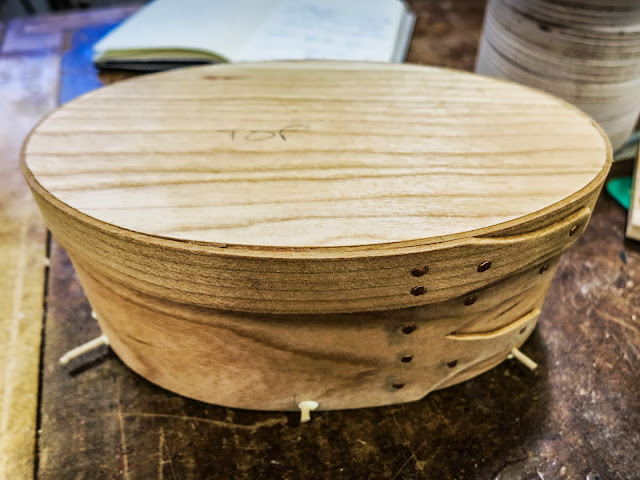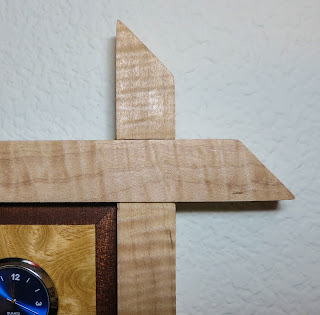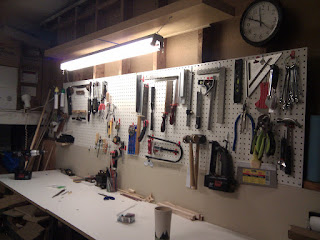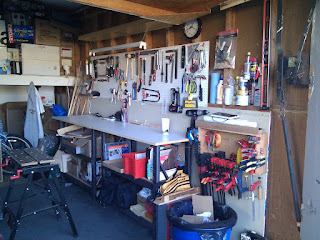Wishing everyone a belated Merry Christmas and a wonderful New Year to Come!!
Tuesday, December 31, 2013
Wednesday, October 9, 2013
Wedding Logo - Marquetry Coasters
A couple of good friends from school got married this spring. I wanted to send them something special to celebrate! Being a designer, she had designed a really cool logo/crest for their invitations and website and favours. I thought it was really cool, and wanted to use it in some way.
It was a bit tricky, since I had a printed version that was about an inch in diameter. I scanned it and blew it up to a size where I could have a chance at cutting it out of wood. Unfortunately, the outer text was still too small, so I decided to opt for the inner section only. I was originally thinking of doing it as an ornament, but Jerome chimed in that he thought something more practical would be fun. And so we came up with the idea of a pair of inverse coasters, which could be both practical and decorative.
Here you can see the marquetry completed. I didn't manage to take any process pictures as it required a lot of concentration to get all the tiny curved parts just right. But you can see that the cut out of one colour becomes the insert on the other. So by cutting both at once very carefully, I ended up with two!
Here is a close up of the front of one of them without the tape.
I cut two circles to final dimension from thin plywood. To make them look nicely finished, I first glued a band of veneer around the circle. You have to do this in two parts. The first is show here, where you glue almost all the way around, and leave long tails. Once this is dry, you cut through both layers at once on the unglued part, so you get a really tight and hopefully invisible seam. You then glue that last little section. The high-tech clamp you use for this process is a bunch of elastic bands!
Next is gluing the top and bottom on. I don't have any pictures as all you really see is a lot of clamps. The top is tricky because it tries to slip off of center when you tighten the clamps. Luckily, it worked out pretty well on these. This one had slipped by a half mm, but I managed to recoup reasonably, and hopefully no one will mind it being out of centered by that tiny amount.
After it's all glued and done, final sanding, I put a bunch of coats of Waterlox finish, to ensure it would be okay if any drips from a glass landed on it. And then I buffed it with wax to make it nice and shiny and give it even more protection.
I also stamped my initials and the year on the backs before finishing. It's a very subtle way to sign a project.
I shipped them out (several months late) and after a lot of fretting and hoping the postal services would do their thing, I got a call from my friend saying it had arrived and they really liked them and had put them on their newly arranged bar area! I hope they'll enjoy them as fun mementos of their happy day!
Sunday, September 8, 2013
Desk Cubby Insert
I've always loved those old roll top desks with the little pigeon holes in them. I like the idea of having little cubbies for everything right where you need them when you're working on something. My desk attaches to one of those Ikea cube book shelves so that I have easy access to my books and such. Earlier this summer I thought It would be cool to build an insert for it where I could keep all my notebooks and papers neatly.
I measured the books and papers that I wanted to include in it, and made sure there were specific places for each. One day I stayed late after work, and using the measurements I had taken, built up my cubby in Solidworks. That way I could make a 1 to 1 pattern for cutting out the pieces and routering all the slots for the dividers. I cut all the pieces to size and then set up the back panel for routering. Each divider gets glued into the slot at the back to give it some strength and help with positioning.
Next I had to work quickly to glue up all the pieces and try and get them all aligned at the front and clamped while the glue was still wet. It took rather a lot of clamps!
One of the internal ribs tilted a degree or two in the glue up, but overall it worked out pretty well. I had pre waxed all the internal faces of the piece so that papers would go in smoothly, and because it would be impossible to do at this point. I did some finish sanding and waxed the outside. You get a sneak peak of some upcoming projects I was also working on in this picture too!
As luck/design would have it, it fit!! Here you can see it in context with the whole shelf. Things for a bit messy in emptying the spot where it was going.
Now I have a handy place for all my notebooks instead of them being in a big pile. It's great, and at a glance it looks like it was built right in!
Saturday, August 24, 2013
Shaker Boxes
Last month our marquetry club had a Saturday workshop where we made Shaker boxes. This may sound strange for a marquetry club, but the idea was that we could add marquetry to the top of our boxes very nicely, and end up with a very different type of project. I had actually made a set of 3 of these boxes years ago at a Lee Valley seminar, but was anxious to get a refresher and learn new tips and tricks, so that I could make some at home.
We started out with thin strips of Cherry, one narrow and one wide for the top and body of the box respectively. The first step is to cut the tabs to shape and predrill the holes as you can see here on the top band. You also have to sand the other end of the band to a thinner thickness so that it lays flat when you bend it.
Next you soak the strips of thin wood in very hot-boiling water for 15 to 20 minutes. Here you can see someone's small band being soaked and the colour that the cherry changes the water!
You bend the body of the box first. You have a plywood or foam form cut to shape, and you take the piece out of the water and bend it around as quick as you can, and then hold it for a few minutes to let it cool down. This is me holding my box body.
When your body is done, you repeat the soaking and bending process, but instead of using the form to bend it, you use the body of the box so that the lid fits on perfectly.
Next we use this cool pipe jig to nail in the tiny copper tacks. They have to be copper so that they bend back on themselves on the inside just like a staple.
Here I am with the top band around the pipe getting ready to hammer in the last tack.
And here is the last tack about halfway in.
Here is my box body with the tabs nailed in place. It is still around the form so that as the wood dries it keeps its shape.
The next thing to do is to cut a bottom insert to match your body. You then give it a slight angle so that it wedges in nice and tightly. You do the same thing for the top. Making sure to label the parts and how they fit in carefully.
The final step is to attach the bottom. You carefully drill holes through the side and bottom pieces. You then take round toothpicks with a tiny dab of glue on them and tap them in place. Once the glue is dry you trim them off and sand a little bit. You do this to the top also, but the plan is to do some marquetry on the lid, so it can't be glued in place until that is done.
Here it is all done except for the marquetry. I'm still working on a design for that so it will be included in an update later. I think I'm going to make some more of these as they are surprisingly quick to make, and a pretty impressive and useful way of giving something with some marquetry on it. As for the special supplies like the tacks, those can be ordered at http://shakerovalbox.com/ where there is also more detailed instructions. There is a whole numbering convention for these type of boxes; the bigger they are the higher the number. It's really cool to think that the shakers have made these types of boxes for 100's of years!
Monday, July 29, 2013
Marquetry Nameplate
A few months ago my best friend completed her Phd. I wanted to make something to celebrate such an amazing achievement. I decided to put my marquetry skills to work. I started my picking a size and a font for a nameplate. I printed it out to scale and using carbon paper transferred the pattern onto some pretty veneers I had in my box. I cut this project with an exacto knife so I could get all the tiny details. The whole thing measured 2"x 6". To cut the letters You cut the hole in the background, and then use that to cut an exact letter to fit in the hole. It's very precise and slow work, but the result of getting a perfect fit is worth it.
Here you can see the hole of the N is cut out and awaiting it's filling. You use a ton of tape - both low tack transfer tape, and regular scotch tape to keep everything in place and to avoid losing pieces!
Here's the lettering complete. It's from the back as the front is covered in tape to hold it all together.
I added a border with mitered corners to make it more official looking.
Gluing is the scary part. Everything can go wrong here and ruin all your delicate work. Luckily with careful taping and alignment, this one worked perfectly. It is glued to a 1/2" piece of plywood. I repeated the process with a plain piece of veneer on the back
To finish the piece I glued strips of matching veneers to the sides to make it look like a solid piece of wood.
Several coats of finish and buffing it with wax bring out the shimmer and colours of the wood. The background is maple and I'm not sure what the redish wood is.
The nameplate can sit on a desk or shelf, or be hung on a wall.
Here's a few detail shots. The letters themselves are 3/4" tall.
You can really see the cool patterns in the wood in these ones.
Wednesday, June 26, 2013
Alkaline Trio Laptop Vinyl
Thursday, June 6, 2013
Inukshuk Marquetry with Clock
I started this project last summer with the intent of finishing it before our big trip. The design is of an inukshuk perched on a rock. An inukshuk is a stone landmark often used by the Inuit or in arctic areas to mark a spot where there aren't other means. They are very interesting and intriguing and you often see images of them in vast uninhabited areas standing guard. I had thought it would make a nice marquetry piece.
The marquetry part went very quickly - I completed it in a several evenings. Picking the veneers was really fun. I had seen the light background in my stash and it reminded me a bit of the northern lights so I thought it was perfect.
The hard part was the frame I had envisioned for it. I had a very particular idea of what I wanted, but it took a while to sort it out. I don't have a table saw, so I got my friend at work to cut the strips of maple which had a nice ripple effect in it. That was as far as I got before we left.
When we returned I got back to it, and decided that since I hadn't done a wood project in a while I should do all the joinery by hand. This was pretty fun, but very time consuming. I have a set of mini planes from Lee Valley which were perfect for this, and it was good practice.
After many hours and lots of patience and finishing an audiobook or two, I got the perfect fit I wanted. The frame pieces each have two recesses to accept the other fram pieces and on the back there is a channel all the way around for the marquetry panel to fit it. I seem to have missed getting a picture of this though.
Then I glued the marquetry to a 1/4" piece of plywood and drilled the hole for the clock.
Not one to leave well enough alone, I added a bit of marquetry to the back as well. It may look familiar from my wooden name tag as it should as this was one of two I made to decide what colours I liked better.
A quick test assembly before putting on the last touches and the finish.
Here it is hanging on the wall all done. You can see I added angles to the corners. You can also see how much the coat of finish brings out the waviness of the wood!
Here's a detail of the nice tight fit I got on the lap joints.
And the back with the hang hole and retaining clips. You can see here how the marquetry is inset into the frame.
Even though I'm almost a year later than I wanted to be, I am very happy with how it turned out in the end. I hope it will be enjoyed by it's recipient!
Tuesday, May 28, 2013
Winter Project Update
So while I seem to be doing not too well on blog posts, I haven't been doing too badly on working on projects. So here is a collection of some of the smaller projects that I've worked on over the winter. I'll be posting full projects of some bigger things in weeks to come.
I started by re-organizing my shop. I got two sheets of pegboard and got all my tools hung up so that they'd have a place that wasn't always on my work table. I also got a light fixture to put above my worktable so I can actually see what I'm doing when its later in the day.
Next I made this quick plywood belt and tie hanger for our closet. I got the metal hook from an old plastic store hanger we had. Then I just drill holes and connected them on the bandsaw to create the slots for the belts. Some sanding and clear coat later, we finally have a place for all our belts and ties that makes sense!
I had a bunch of old files from my great uncle and grandfather that I like to use, but that had no handles. I took the opportunity to practice my turning and made some! I just used plumbing nuts for the metal ferrules - they're inexpensive and do the trick nicely. I used some small pieces of wood I had leftover and even tried burning in lines on the bigger one. Now I use them much more often since they're actually comfortable to hold!
I found this cute tutorial for fabric labels a few years ago, and finally got around to making some. You print your design on iron on transfers, and then iron it to twill tape that you sew onto your projects. I did a variety of different designs and colours so I will hopefully have something handy for any project I do in the next while.
Here's one of them stitched onto a baby blanket I made.
I had a stash of cute flannelette that I got made into little baby blankets and got to try out the sewing labels.
I also got this amazing stuff called padding compound. Its that weird plastic-y stuff that holds pads of paper together at the top. It's really neat because you can just paint it onto any stack of paper you have and turn it into a note pad! I think it's really fun, Jerome is sure I'm crazy.
It's a bit hard to see as it dries clear. I've made several custom notepads for lists using both printer paper and index cards. It's really easy to use, you just clamp your paper together - the tighter the better - brush on the stuff and wait a few hours. I have lots of ideas for neat notepads!
Labels:
organizing,
project,
Sewing,
shop,
tools,
woodworking
Subscribe to:
Posts (Atom)







